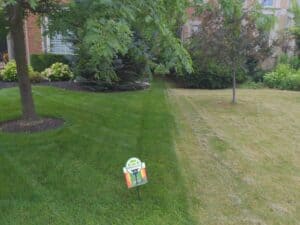Mowing
Mowing
Proper Mowing & Watering is essential to a Green, Thick and Healthy Lawn.
Here are the facts for lawns in the Greater Toronto Area (and similar growing districts with cool-season grass varieties)
Height
This one is easy- 2.75 – 3 inches in the spring (May-June and fall (September-November) and 3 inches in the hotter and drier summer periods. Contrary to popular belief- If you cut the lawn shorter it does not make it grow at a slower rate. (just like your hair). For mowing tips after OverSeeding click here .
Proper height also prevents moisture loss through evaporation so it doesn’t dry out too quickly, and keeps the root system cooler. The taller the grass the deeper the roots.
Frequency
THIS IS YOUR MOST IMPORTANT CONTRIBUTION TO ACHIEVE GREAT RESULTS! The easiest way to do your part for a greener, thicker and healthier lawn with less weeds is to mow your lawn frequently. Golf Courses know this, and their lawns are super thick and lush. As a general rule you should mow your lawn every 5-7 days.
HOWEVER, when the lawn is growing fast- you should mow 2X per week. (Late April-June / September-October)
Now we understand that this SEEMS hard to do. But please consider this, when you mow more frequently, you’ll achieve the following important benefits:
more frequently, you’ll achieve the following important benefits:
- Stimulates shoot growth and lateral spread of the grass plant. This means your lawn will get thicker, quicker. A thicker lawn crowds out weeds, Think of a cedar hedge and how it grows thicker the more frequently you trim it.
- There is actually less work to do each time, including no bagging clippings and no raking required. when you are only mowing off <1″ of the plant, this is so easy to do. And you dont have to trim every time you mow. this means you can perform the task in less time. (and more fresh cur grass smell!)
- Weeds grow more rapidly and taller than the rest of the lawn, so when they dont have a chance to grow that high, they naturally are in a weakened state, allowing us to kill them easier.
- Most weeds tend to flower at a certain height that is taller than the rest of the lawn kept at 3″. Once a weed flowers, it produces seed heads, which in turn produces more weeds.
- Your lawn will look better! In fact, I have not yet had a customer call us, who follows our mowing and watering plan properly to tell me it didn’t work. (obviously it must be done in conjunction with a properly suited lawn care program)
Another important rule of thumb is to never allow your grass to grow long enough that you would be cutting more than 1/3 of the blade off in a single mowing. In the summer, if the lawn isn’t growing fast, mow when needed using the one-third rule. Try to mow when the lawn is dry for best results! and not during the high heat of the day abs this causes additional stress.
Keep your Blade Sharp
Mower blades dull easily and can dull blades tear blades rather than slicing them. Torn blades turn brown very quickly giving the lawn a brownish yellow appearance. Even worse- it invites disease into the lesion. For an average size lawn, sharpen your blade twice a year. Either bring your lawn mower into a repair shop or use a Grinder- Be sure to remove the blade first according to manufacturer’s directions.
Alternate your Mowing Direction
When you see it on a baseball diamond we call it “signature cutting”. The main reason is to prevent rutting in the soil but also prevents grass from learning to lean a certain way. It also helps the grass to stand up straighter for a better overall appearance, and a healthier lawn.
Clippings
The best thing to do is mow often enough so that the clippings produced are always really small. This is called “Grass-cycling”. (EXCEPT when you have a weed infestation)
IMPORTANT: When you have a weed problem, it is proactive & essential to bag your clippings (with a bag attachment- not raking) to prevent the spread of weeds! Whenever weeds are “in seed” you can prevent the spread of these weed seeds through your lawn by not dispersing them through the mower chute, but bagging the clippings instead. Once the turf grass has filled in thicker and the weeds are in control, you can resume GrassCycling,
The Benefit of Grass-cycling is that it reduces the time it takes to mow the lawn, saves energy, saves money, and saves landfill space. PLUS- It returns valuable nutrients back to the lawn! The problem is- Most people don’t mow often enough- (It’s a lot easier and takes less time overall to mow twice a week than to mow a long lawn once a week). Mulching mowers are meant to be used more often- or else they clog up. Never leave clippings longer than one inch (2.5 cm) on your lawn. If you missed a mowing it’s better to bag them- or else you’ll soon have a ton of thatch! Be a GrassCycler!
Keep your Lawn Mower Clean Underneath
Residue from grass clippings will build up underneath your lawn mower deck and make it a lot harder work. Clean the deck a few times a year as necessary to keep your mower in like-new condition and prevent clogging.
Tune-Up
Old lawn mowers are energy hogs, a well tuned machine will burn gas more efficiently with less emissions. Every spring, change the spark plug, change the oil, grease the wheels, sharpen the blade, clean or change the air filter and watch that puppy purr!
* Before performing any of the previous maintenance tasks- ensure you follow safety recommendations of the manufacturer or have an expert help you.
Mowing After Over-seeding
If over-seeding for the purpose of repair:
If seeding to repair large bare patches ( you will have used more seed per square foot than a typical overseeding for thickening) You’ll need to mow as needed on newly-seeded bare areas, once it requires a cut (meaning about 4 inches in length), but please tread gently. Try to minimize turns and keep mowing rows to a minimum. Do not leave clumps of clippings on the seeded area that will bury the new seedlings (please bag them).
You can resume regular mowing of that newly seeded area once the new plants are hardened off and established. (normally 4-6 weeks)
If the area being seeded is among mature grass:
(spot seeding or regular over-seeding to introduce newer varieties of turf-grass species to the lawn), you need to carry on with regular mowing, but in a more careful fashion in order to lessen disturbance of the new seedlings.
Mowing after Fresh New Sod is installed:
If your lawn has been newly sodded, it’s important to handle the first few cuts carefully. With proper watering, new sod in the GTA can grow quickly – often reaching 4–6 inches within the first week.
Waiting too long or cutting too much at once can shock the new turf and cause yellowing, while mowing too early can pull up seams before the sod has rooted.
For step-by-step guidance on when to start, how to mow safely, and what equipment to use, visit our full article on How to Mow After Fresh Sodding.






